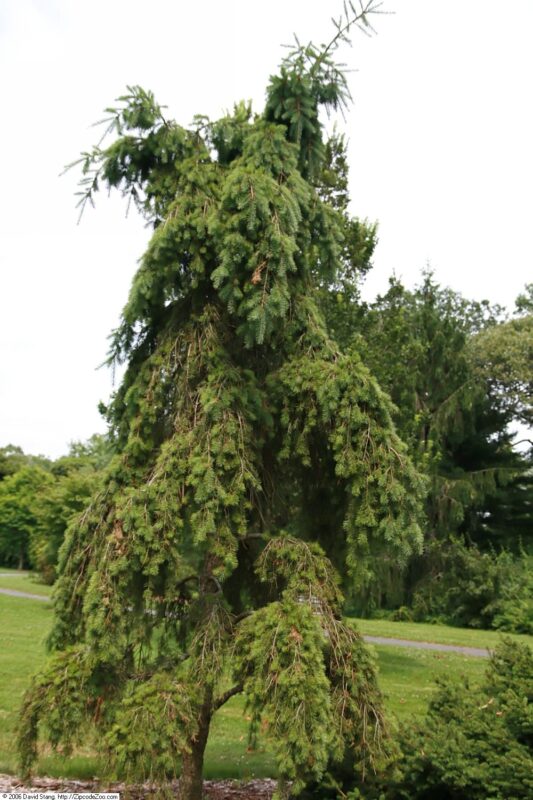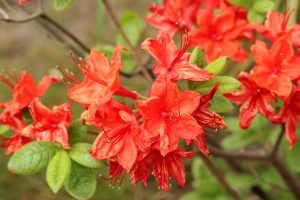Below, we will explore a variety of weeping evergreens, each with distinctive traits and stories that add to their appeal.
Weeping Blue Atlas Cedar

The Weeping Blue Atlas Cedar (Cedrus atlantica ‘Glauca Pendula’) is renowned for its striking silvery-blue foliage and elegant drooping branches that create a truly enchanting display. This tree originates from the Atlas Mountains of Morocco and Algeria, where it thrives in mountainous terrain.
As it matures, the weeping branches can stretch up to 10 feet long, forming a cascading effect that’s both whimsical and sophisticated. This evergreen is ideal for large gardens or as a focal point in a landscape, attracting attention with its stunning color contrasts. Besides its visual appeal, it serves as a habitat for numerous birds and insects, enriching local biodiversity.
Planting Weeping Blue Atlas Cedar requires a sunny location with well-draining soil. It’s imperative to note that while this tree can adapt to various soil types, it will perform best in slightly acidic to neutral pH levels. Regular watering during the first few years helps establish its roots, allowing it to thrive in a variety of environments over time.
Weeping Norway Spruce

The Weeping Norway Spruce (Picea abies ‘Pendula’) is a fascinating conifer known for its long, drooping branches that appear almost like waterfalls of greenery. Native to Northern Europe, this tree showcases dark green needles that contrast beautifully with its grayish-brown bark.
One of the most remarkable aspects of the Weeping Norway Spruce is its ability to withstand harsh conditions, making it a fantastic choice for gardeners in colder climates. Often used for windbreaks or as a solitary specimen in large yards, its weeping form makes it a unique and eye-catching specimen.
Maintenance of the Weeping Norway Spruce is relatively easy, but it does benefit from a good pruning regimen to maintain its shape and promote healthy growth. Fostering its natural cascading form while removing any dead or damaged branches can enhance its aesthetic appeal.
Weeping White Pine

The Weeping White Pine (Pinus strobus ‘Pendula’) is a captivating variety of the native Eastern White Pine, well-appreciated for its soft, flexible branches that droop gracefully toward the ground. This tree is particularly unique for its long, slender needles, which provide a lush appearance and delicate texture.
Growing to about 10 to 15 feet tall with a spread of 20 feet, the Weeping White Pine can serve as a stunning focal point in any landscape setting. It tends to thrive in full sun to partial shade and prefers well-drained soils. Its adaptability makes it suitable for various applications, whether in residential gardens or public parks.
One of the best features of this tree is its ability to create natural privacy screens thanks to its dense growth habit, while delivering a visually intriguing element to your garden design.
Weeping Alaskan Cedar

The Weeping Alaskan Cedar (Chamaecyparis nootkatensis ‘Pendula’), also known as Nootka Cypress, is a striking low-growing evergreen with gracefully weeping branches adorned with soft, scale-like leaves. Native to the coastal regions of North America, specifically Alaska and British Columbia, this tree brings a touch of the Pacific Northwest to any garden.
Alaskan Cedars are particularly known for their resistance to pests and diseases, making them a smart and enduring choice for landscaping. They prefer a slightly acidic, well-drained soil but are surprisingly tolerant of various soil types. Full sun exposure will encourage their majestic growth, with a mature height of about 10 to 20 feet.
Incorporating Weeping Alaskan Cedar into your landscape creates a serene ambiance, often reminiscent of the tranquil coastal forests they hail from. Their unique shape and soft foliage help to soften hardscapes, providing a lush contrast against more rigid elements.
Weeping Serbian Spruce

The Weeping Serbian Spruce (Picea omorika ‘Pendula’) is celebrated for its graceful form and beautiful, two-toned needles. Native to the mountainous regions of Serbia, this evergreen boasts a unique blend of upright leading branches, which give way to pendulous side branches, creating a truly enchanting silhouette.
This spruce is particularly remarkable for its resilience in urban environments, making it suitable for various settings, including gardens, parks, and streetscapes. With a mature height of around 10 to 15 feet, it serves as an elegant specimen tree that draws the eye without overpowering surrounding plants.
To keep the Weeping Serbian Spruce healthy, it’s essential to plant it in well-drained acidic soil and provide it with a full sun location. Regular watering, especially during dry spells, will ensure its ongoing vitality and lush appearance.
Weeping Douglas Fir

The Weeping Douglas Fir (Pseudotsuga menziesii ‘Pendula’) is a unique cultivar of one of North America’s most popular evergreen trees. Known for its soft, feathery needles and upright, graceful weeping branches, this fir offers a wonderful spectacle in any garden setting.
Mature Douglas Firs can reach heights of 15 to 30 feet, making them suitable as dramatic landscape elements. They flourish in full sun and prefer well-draining, slightly acidic soil. This tree is an excellent choice for gardeners who desire both beauty and functionality, as its robust structure provides habitat and food for wildlife.
Maintenance of the Weeping Douglas Fir is straightforward. Regular pruning can help maintain its signature cascading form, while also encouraging healthy growth and resilience against disease. Planting it among other weeping and upright companions can create a stunning contrast in any landscape design.
Weeping Himalayan Cedar

The Weeping Himalayan Cedar (Cedrus deodara ‘Pendula’) is a majestic variety endemic to the western Himalayas, recognized for its elegant, sweeping branches that create an impressive visual. The aromatic foliage exudes a peaceful aura, often evoking a sense of tranquility in any garden.
As this tree matures, it can reach heights of 40 feet or more, with a spread of about 20 feet. Its adaptability to various climates has made it a beloved choice in gardens across the globe, thriving in full sun and well-draining soil.
Incorporating a Weeping Himalayan Cedar into your landscape design not only enhances the aesthetic appeal but also invites birds and other wildlife. Additionally, its aromatic foliage makes it a wonderful choice for those seeking a sensory experience in their gardens.
Weeping Giant Sequoia

The Weeping Giant Sequoia (Sequoiadendron giganteum ‘Pendula’) is one of nature’s marvels. Recognized for its substantial size and age, this tree can live for over a thousand years. Its weeping form adds a unique twist to the already fascinating character of the giant sequoia.
As a majestic tree, the Weeping Giant Sequoia can reach impressive heights of over 25 feet, often creating a stunning focal point in gardens and parks. While it prefers deep, well-drained soils and full sunlight, this tree can tolerate a variety of conditions.
To care for these giants, regular watering during dry periods is crucial, especially in their early years. This will encourage strong root development and facilitate their impressive growth. In landscapes, the Weeping Giant Sequoia provides a dramatic presence that showcases the strength and durability of evergreens.
Weeping Threadleaf Arborvitae

The Weeping Threadleaf Arborvitae (Thuja occidentalis ‘Filiformis’) is a charming evergreen that stands out for its delicate, thread-like foliage that hangs gracefully from its branches. This unique form gives it a whimsical appearance, and it has become increasingly popular in garden design.
Mature specimens can reach heights of about 6 to 10 feet, making them suitable for smaller gardens or as accent plants in larger landscapes. Weeping Threadleaf Arborvitae is adaptable to a range of soil types, though it flourishes best in moist, well-drained settings with plenty of sunlight.
The fine-textured foliage of this arborvitae creates a softening effect in landscape designs, providing contrast against more rigid features. Regular watering and occasional pruning can enhance its cascading appearance, allowing it to be a focal point or a gentle backdrop in your garden.
Weeping Scots Pine

The Weeping Scots Pine (Pinus sylvestris ‘Pendula’) is a delightful cultivar that brings a touch of the natural world to garden designs. Characterized by its orange-brown bark and slender blue-green needles, this tree has a unique way of capturing the eye.
Maturing to about 15 to 20 feet tall, the Weeping Scots Pine is an excellent choice for landscapes where both height and character are desired. It prefers full sun and well-drained soil, thriving in areas with ample moisture.
What sets the Weeping Scots Pine apart is its resilient nature and adaptability to various conditions, making it an ideal specimen for gardens that experience fluctuating weather or soil conditions. With a bit of seasonal pruning, gardeners can maintain its signature shape and promote healthier growth.
Weeping Colorado Blue Spruce

The Weeping Colorado Blue Spruce (Picea pungens ‘Pendula’) is a striking choice for any garden needing a touch of color and drama. Known for its stunning silvery-blue needles, this tree brings a unique palette to wider landscapes and smaller gardens alike.
Growing up to 10 to 15 feet tall, the Weeping Colorado Blue Spruce is a stunning specimen that enjoys full sun and well-drained soil, ideally with slightly acidic conditions. Its distinctive weeping branches create a flowing silhouette that complements many landscaping styles.
Caring for this spruce involves regular watering, particularly during dry spells. It can also benefit from occasional pruning to shape its form and promote healthy, vigorous growth. Planted alongside hardy perennials or flowering plants, the Weeping Colorado Blue Spruce can create stunning visual interest in your garden.
Weeping Yaupon Holly

The Weeping Yaupon Holly (Ilex vomitoria ‘Pendula’) is a unique evergreen that offers both beauty and functionality. With its slender, weeping branches adorned with small, glossy leaves, this shrub provides an elegant alternative to traditional upright evergreens.
Typically growing to about 5 to 6 feet tall, the Weeping Yaupon Holly is perfect for smaller spaces or as part of a mixed hedging design. It thrives in full sun to partial shade and handles various soil types, though it prefers moist, well-draining conditions.
In addition to its delightful foliage, this holly variety produces red berries in the fall, attracting birds and wildlife to your garden. Regular pruning helps maintain its weeping form, promoting a bushier appearance and enhancing its overall aesthetic.
Weeping Brewer Spruce

The Weeping Brewer Spruce (Picea breweriana ‘Pendula’) is an intriguing Evergreen whose distinctive weeping habit captures attention instantly. Native to the Pacific Northwest, this spruce is celebrated for its unique, drooping branches that can extend several feet, creating a veil of greenery.
This tree grows to about 30 feet tall at maturity, performing best in a planting where it has adequate room to express its natural form. Full sunlight and well-drained soil are preferences for this majestic tree to thrive; proper care includes regular watering.
Weeping Brewer Spruce lends a distinct character to gardens, being both a statement piece and a subtle addition to a larger landscaping scheme. Its cascading branches create a calming effect, evoking the tranquility of forest glades.
Weeping Eastern Red Cedar

The Weeping Eastern Red Cedar (Juniperus virginiana ‘Pendula’) is a charming evergreen that stands out with its soft, textured foliage. This tree is particularly renowned for its drought tolerance and adaptability, making it an excellent choice for landscapes that endure varying weather conditions.
Maturing at a height of about 15 feet, the Weeping Eastern Red Cedar beautifully complements gardens alongside other ornamental plants. It thrives in well-drained soil and enjoys full sun, allowing its foliage to develop its rich, bluish-green hue.
Not only does this tree enhance the beauty of your landscape, but it also provides excellent habitat for birds and small animals, contributing to local ecosystem health. Modest pruning helps to promote a healthy, cascading form, allowing it to be both a soothing presence and a striking landscape feature.
Weeping Hemlock

The Weeping Hemlock (Tsuga canadensis ‘Pendula’) is widely admired for its delicate, lacy foliage and looser growth habit. A favorite among gardeners, this hemlock species features soft, green needles that droop gracefully, creating a peaceful and serene atmosphere in landscaping.
Generally maturing to around 10 to 20 feet in height, the Weeping Hemlock is well-suited for both mixed gardens and as a stand-alone specimen. It thrives in partial shade to full sun, favoring moist, well-draining soil that supports its lavish growth.
As a unique focal point, the Weeping Hemlock can soften the edges of hardscapes and provide visual contrast with bolder plants or structures. Its gentle form and lush foliage offer a calming presence, marrying form and function in any garden design.





